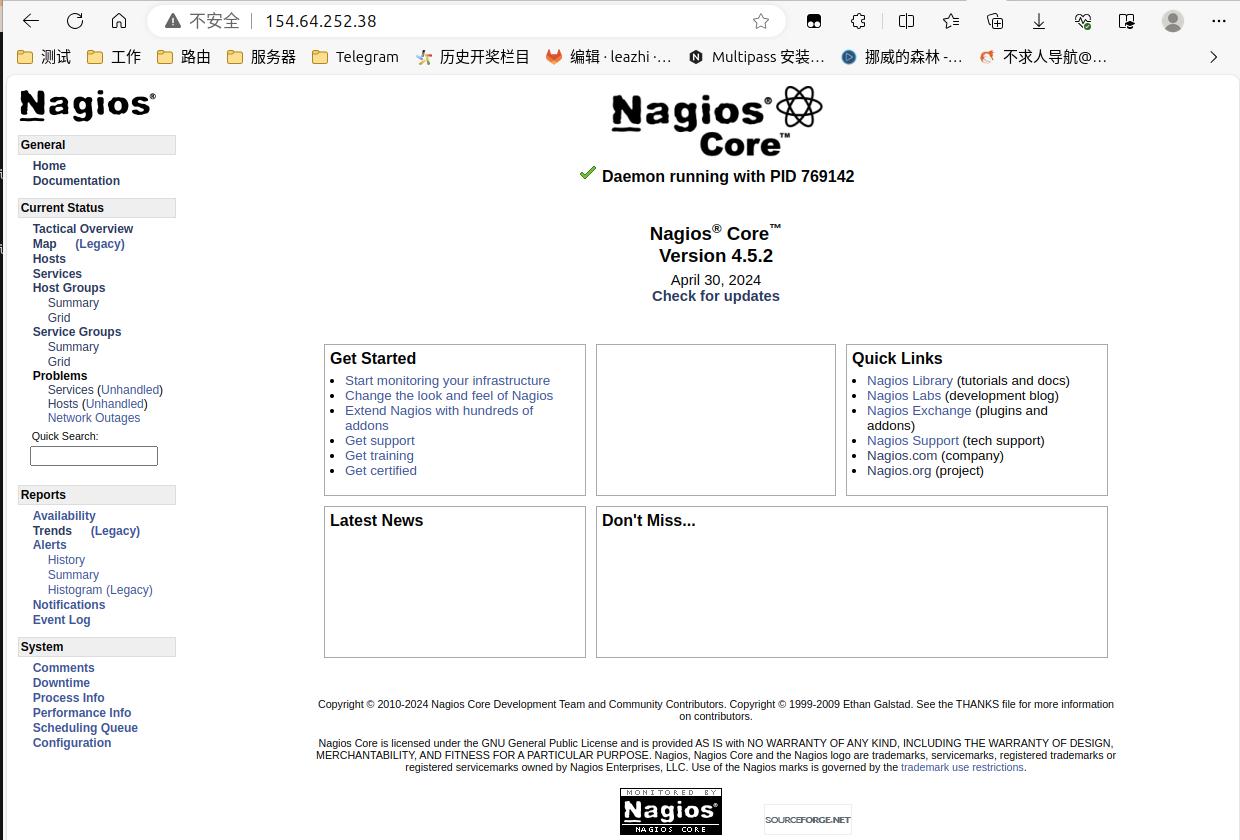系统环境
标题
版本
备注
系统版本
ubuntu 22.04.3 LTS (Jammy Jellyfish)
-
内核版本
5.15.0-91-generic #98-Ubuntu SMP Mon Oct 2 15:18:56 UTC 2023 x86_64 x86_64 x86_64 GNU/Linux
-
Tengine
v3.1.0
-
PHP
v7.4.30
-
MariaDB
v10.11.7
-
Nagios Core
v4.5.2
-
Nagios Plugins
v2.4.10
-
NRPE
V4.0.2
-
nagios 简介 Nagios 官方网址: https://www.nagios.org/
Nagios 是一款流行的开源网络监控系统,它提供了全面的主机、服务器、网络监控和报警功能。以下是对 Nagios 的一个简要介绍:
监控能力
主机资源监控(CPU、内存、磁盘等)
网络服务监控(HTTP、SMTP、FTP等)
网络协议监控(PING、SNMP等)
日志文件监控
数据库监控
中间件监控(如JMX)
云资源监控
通知警报
支持多种通知方式(邮件、短信、脚本执行等)
支持基于阈值的警报触发
支持多级别的通知escalation
集中管理
提供基于Web的管理界面
支持分布式监控环境的中央管理
支持LDAP/AD用户认证
扩展性
提供插件架构,支持自定义插件扩展
支持主动/被动检查
支持并行服务检查
报告和数据存储
提供多种格式的报告(HTML、CSV等)
使用高性能的日志文件存储监控数据
可通过第三方工具实现数据可视化
社区支持
Nagios 核心是开源免费的,但其公司 Nagios Enterprises 也提供了商业版本和支持服务。Nagios 被广泛应用于各种规模的企业网络监控,是事实上的网络监控标准之一。
LTMP 环境安装 关于 LTMP 环境中的 Tengine 安装,请参考:在 ubuntu 22.04 中,通过源码编译安装 LTMP 中的 Tengine 服务(不支持 Lua 脚本语言)
关于 nagios 虚拟主机的配置如下:
1 2 3 4 5 6 7 8 9 10 11 12 13 14 15 16 17 18 19 20 21 22 23 24 25 26 27 28 29 30 31 32 33 34 35 36 37 38 39 40 41 42 43 44 45 46 server { listen 80; server_name _; auth_basic "Nagios Access" ; auth_basic_user_file /usr/local/nagios/etc/.htpassword; location / { root /usr/local/nagios/share; index index.php; } location ~ \.php$ { root /usr/local/nagios/share; fastcgi_pass 127.0.0.1:9000; fastcgi_index index.php; fastcgi_param SCRIPT_FILENAME $document_root$fastcgi_script_name ; include fastcgi_params; } location /nagios { alias /usr/local/nagios/share; } location /cgi-bin/images { alias /usr/local/nagios/share/images; } location /cgi-bin/stylesheets { alias /usr/local/nagios/share/stylesheets; } location /cgi-bin { alias /usr/local/nagios/sbin; } location ~ .*\.(cgi|pl)?$ { gzip off; root /usr/local/nagios/sbin; rewrite ^/nagios/cgi-bin/(.*)\.cgi /$1 .cgi break ; fastcgi_pass unix:/usr/local/nginx/logs/perl-fcgi.sock; fastcgi_param SCRIPT_FILENAME /usr/local/nagios/sbin$fastcgi_script_name ; fastcgi_index index.cgi; fastcgi_param REMOTE_USER $remote_user ; fastcgi_param HTTP_ACCEPT_LANGUAGE en_US; include fastcgi_params; fastcgi_read_timeout 60; } }
需要注意的是: start_perl_cgi.sh 中定义的用户一致,否则在 nginx 的错误日志中会出现 connect() to unix:/usr/local/nginx/logs/perl-fcgi.sock failed (13: Permission denied) 问题,进而影响 nagios web 端显示不正常的情况!!!
Perl 模块安装 Perl 模块 - FCGI 1.点击这里下载 FCGI 模块源码包文件 到服务器的 /usr/local/src/ 目录下:
1 wget -O /usr/local/src/FCGI-0.82.tar.gz https://cpan.metacpan.org/authors/id/E/ET/ETHER/FCGI-0.82.tar.gz
2.将下载的源码文件解压到下载目录:
1 tar -zxf /usr/local/src/FCGI-0.82.tar.gz -C /usr/local/src/
3.进入解压目录:
1 cd /usr/local/src/FCGI-0.82/
4.执行 perl Makefile.PL 命令:
5.执行 make 命令进行编译:
6.执行 make install 命令进行安装:
Perl 模块 - FCGI::ProcManager 1.点击这里下载 FCGI::ProcManager 模块源码包文件 到服务器的 /usr/local/src/ 目录下:
1 2 wget -O /usr/local/src/FCGI-ProcManager-0.28.tar.gz https://cpan.metacpan.org/authors/id/A/AR/ARODLAND/FCGI-ProcMan ager-0.28.tar.gz
2.将下载的源码文件解压到下载目录:
1 tar -zxf /usr/local/src/FCGI-ProcManager-0.28.tar.gz -C /usr/local/src/
3.进入解压目录:
1 cd /usr/local/src/FCGI-ProcManager-0.28/
4.执行 perl Makefile.PL 命令:
5.执行 make 命令进行编译:
6.执行 make install 命令进行安装:
Perl 模块 - IO 1.点击这里下载 IO 模块源码包文件 到服务器的 /usr/local/src/ 目录下:
1 wget -O /usr/local/src/IO-1.55.tar.gz https://cpan.metacpan.org/authors/id/T/TO/TODDR/IO-1.55.tar.gz
2.将下载的源码文件解压到下载目录:
1 tar -zxf /usr/local/src/IO-1.55.tar.gz -C /usr/local/src/
3.进入解压目录:
1 cd /usr/local/src/IO-1.55/
4.执行 perl Makefile.PL 命令:
5.执行 make 命令进行编译:
6.执行 make install 命令进行安装:
Perl 模块 - IO::ALL 1.点击这里下载 IO::ALL 模块源码包文件 到服务器的 /usr/local/src/ 目录下:
1 wget -O /usr/local/src/IO-All-0.87.tar.gz https://cpan.metacpan.org/authors/id/F/FR/FREW/IO-All-0.87.tar.gz
2.将下载的源码文件解压到下载目录:
1 tar -zxf /usr/local/src/IO-All-0.87.tar.gz -C /usr/local/src/
3.进入解压目录:
1 cd /usr/local/src/IO-All-0.87/
4.执行 perl Makefile.PL 命令:
5.执行 make 命令进行编译:
6.执行 make install 命令进行安装:
安装 perl 脚本 1.在 nginx 安装目录 /usr/local/nginx/ 下创建 perl-fcgi.pl 和 start_perl_cgi.sh 文件:
perl-fcgi.pl start_perl_cgi.sh 在 /usr/local/nignx/ 目录下创建 perl-fcgi.pl 文件,内容如下
1 2 3 4 5 6 7 8 9 10 11 12 13 14 15 16 17 18 19 20 21 22 23 24 25 26 27 28 29 30 31 32 33 34 35 36 37 38 39 40 41 42 43 44 45 46 47 48 49 50 51 52 53 54 55 56 57 58 59 60 61 62 63 64 65 66 67 68 69 70 71 72 73 74 75 76 77 78 79 80 81 82 83 84 85 86 87 88 89 90 91 92 93 94 95 96 97 98 99 100 101 102 103 104 105 106 107 108 109 110 111 112 113 114 115 116 117 118 119 120 121 122 123 124 125 126 127 128 129 130 131 132 133 134 135 136 137 138 139 140 141 142 143 144 145 146 147 148 149 150 151 152 153 154 155 156 157 158 159 160 161 162 163 164 165 166 167 168 169 170 171 172 173 174 175 176 177 178 179 180 181 182 183 184 185 186 187 188 189 190 191 192 193 194 195 196 197 198 199 200 201 202 203 204 205 206 207 208 209 210 211 212 213 214 215 216 217 218 219 220 221 222 223 224 225 226 use FCGI;use Getopt::Long;use IO::All;use Socket; sub init GetOptions( "h" => \$help, "verbose!" =>\$verbose, "pid=s" => \$filepid, "l=s" => \$logfile, "S:s" => \$unixsocket, "P:i" => \$unixport) or usage(); usage() if $help; print " Starting Nginx-fcgi\n" if $verbose; print " Running with $> UID" if $verbose; print " Perl $]" if $verbose; if ( $> == "0" ) { print "\n\tERROR\tRunning as a root!\n" ; print "\tSuggested not to do so !!!\n\n" ; exit 1 ; } if ( ! $logfile ) { print "\n\tERROR\t log file must declared\n" . "\tuse $0 with option -l filename\n\n" ; exit 1 ; } print " Using log file $logfile\n" if $verbose; "\n\n" >> io($logfile); addlog($logfile, "Starting Nginx-cfgi" ); addlog($logfile, "Running with $> UID" ); addlog($logfile, "Perl $]" ); addlog($logfile, "Testing socket options" ); if ( ($unixsocket && $unixport) || (!($unixsocket) && !($unixport)) ) { print "\n\tERROR\tOnly one option can be used!\n" ; print "\tSuggested (beacuse of speed) is usage UNIX socket -S \n\n" ; exit 1 ; } if ($unixsocket) { print " Daemon listening at UNIX socket $unixsocket\n" if $versbose; addlog($logfile, "Deamon listening at UNIX socket $unixsocket" ); } else { print " Daemon listening at TCP/IP socket *:$unixport\n" if $verbose; addlog($logfile, "Daemon listening at TCP/IP socket *:$unixport" ); } if ( -e $filepid ) { print "\n\tERROR\t PID file $filepid already exists\n\n" ; addlog($logfile, "Can not use PID file $filepid, already exists." ); exit 1 ; } if ( $unixsocket ) { print " Creating UNIX socket\n" if $verbose; $socket = FCGI::OpenSocket( $unixsocket, 10 ); if ( !$socket) { print " Couldn't create socket\n" ; addlog($logfile, "Couldn't create socket" ); exit 1 ; } print " Using UNIX socket $unixsocket\n" if $verbose; } else { print " Creating TCP/IP socket\n" if $verbose; $portnumber = ":" .$unixport; $socket = FCGI::OpenSocket( $unixport, 10 ); if ( !$socket ) { print " Couldn't create socket\n" ; addlog($logfile, "Couldn't create socket" ); exit 1 ; } print " Using port $unixport\n" if $verbose; } addlog($logfile, "Socket created" ); if ( ! $filepid ) { print "\n\tERROR\t PID file must declared\n" . "\tuse $0 with option -pid filename\n\n" ; exit 1 ; } print " Using PID file $filepid\n" if $verbose; addlog($logfile, "Using PID file $filepid" ); my $pidnumber = $$; $pidnumber > io($filepid); print " PID number $$\n" if $verbose; addlog($logfile, "PID number $pidnumber" ); } sub addzero my ($date) = shift ; if ($date < 10 ) { return "0$date" ; } return $date; } sub logformat my ($sec,$min,$hour,$mday,$mon,$year,$wday,$yday,$iddst) = localtime (time ); my $datestring; $year += 1900 ; $mon++; $mon = addzero($mon); $mday = addzero($mday); $min = addzero($min); $datestring = "$year-$mon-$mday $hour:$min" ; return ($datestring); } sub addlog my ($log_file, $log_message) = @_; my $curr_time = logformat(); my $write_message = "[$curr_time] $log_message" ; $write_message >> io($log_file); "\n" >> io($log_file); } sub printerror my $message = @_; print "\n Nginx FastCGI\tERROR\n" . "\t $message\n\n" ; exit 1 ; } sub usage print "\n Nginx FastCGI \n" . "\n\tusage: $0 [-h] -S string -P int\n" . "\n\t-h\t\t: this (help) message" . "\n\t-S path\t\t: path for UNIX socket" . "\n\t-P port\t\t: port number" . "\n\t-p file\t\t: path for pid file" . "\n\t-l file\t\t: path for logfile" . "\n\n\texample: $0 -S /var/run/nginx-perl_cgi.sock -l /var/log/nginx/nginx-cfgi.log -pid /var/run/nginx-fcgi.pid\n\n" ; exit 1 ; } init; END() { } BEGIN() { } *CORE::GLOBAL::exit = sub die "fakeexit\nrc=" .shift()."\n" ; }; eval q{exit} ; if ($@) { exit unless $@ =~ /^fakeexit/ ; } ; my $pid = fork (); if ( $pid == 0 ) { &main; exit 0 ; } print " Forking worker process with PID $pid\n" if $verbose;addlog($logfile, "Forking worker process with PID $pid" ); print " Update PID file $filepid\n" if $verbose;addlog($logfile, "Update PID file $filepid" ); $pid > io($filepid); print " Worker process running.\n" if $verbose;addlog ($logfile, "Parent process $$ is exiting" ); exit 0 ; sub main $request = FCGI::Request( \*STDIN, \*STDOUT, \*STDERR, \%req_params, $socket ); if ($request) { request_loop()}; FCGI::CloseSocket( $socket ); } sub request_loop while ( $request->Accept() >= 0 ) { $stdin_passthrough = '' ; $req_len = 0 + $req_params{'CONTENT_LENGTH' }; if (($req_params{'REQUEST_METHOD' } eq 'POST' ) && ($req_len != 0 ) ){ while ($req_len) { $stdin_passthrough .= getc (STDIN); $req_len--; } } if ( (-x $req_params{SCRIPT_FILENAME} ) && (-s $req_params{SCRIPT_FILENAME} ) && (-r $req_params{SCRIPT_FILENAME} ) ){ foreach $key ( keys %req_params){ $ENV{$key} = $req_params{$key}; } if ( $verbose ) { addlog($logfile, "running $req_params{SCRIPT_FILENAME}" ); } open $cgi_app, '-|' , "echo '$stdin_passthrough' | '$req_params{SCRIPT_FILENAME}'" or print ("Content-type: text/plain\r\n\r\n" ); print "Error: CGI app returned no output - Executing $req_params{SCRIPT_FILENAME} failed !\n" ; if ($cgi_app) { print <$cgi_app>; close $cgi_app; } } else { print ("Content-type: text/plain\r\n\r\n" ); print "Error: No such CGI app - $req_params{SCRIPT_FILENAME} may not exist or is not executable by this process.\n" ; addlog($logfile, "Error: No such CGI app - $req_params{SCRIPT_FILENAME} may not exist or is not executable by this process." ); } } }
在 /usr/local/nignx/ 目录下创建 start_perl_cgi.sh 文件,内容如下
1 2 3 4 5 6 7 8 9 10 11 12 13 14 15 16 17 18 19 20 21 22 23 24 25 26 27 28 29 30 31 32 33 34 35 36 37 38 39 40 #!/bin/bash dir =/usr/local/nginx/ stop { kill $(cat $dir /logs/perl-fcgi.pid) rm $dir /logs/perl-fcgi.pid 2>/dev/null rm $dir /logs/perl-fcgi.sock 2>/dev/null echo "stop perl-fcgi done" } start { rm $dir /now_start_perl_fcgi.sh 2>/dev/null chown nginx.nginx $dir /logs echo "$dir /perl-fcgi.pl -l $dir /logs/perl-fcgi.log -pid $dir /logs/perl-fcgi.pid -S $dir /logs/perl-fcgi.sock" >>$dir /now_start_perl_fcgi.sh chown nginx.nginx $dir /now_start_perl_fcgi.sh chmod u+x $dir /now_start_perl_fcgi.sh sudo -u nginx $dir /now_start_perl_fcgi.sh echo "start perl-fcgi done" } case $1 in stop) stop ;; start) start ;; restart) stop start ;; esac
2.赋予两个脚本可执行权限:
1 chmod +x /usr/local/nginx/{perl-fcgi.pl,start_perl_cgi.sh}
3.启动 perl-cgi:
1 2 root@instance-2UkeKOzr:/usr/local/nginx start perl-fcgi done
4.确保在 nginx 日志目录 /usr/local/nginx/logs/ 目录下有生成 perl-fcgi.sock、perl-fcgi.log 以及 perl-fcgi.pid 三个文件:
1 2 3 4 root@instance-2UkeKOzr:/usr/local/nginx -rw-rw-r-- 1 nginx nginx 581 May 11 07:32 perl-fcgi.log -rw-rw-r-- 1 nginx nginx 6 May 11 07:32 perl-fcgi.pid srwxrwxr-x 1 nginx nginx 0 May 11 07:32 perl-fcgi.sock
nagios 安装 1.添加运行 nagios 系统用户:
1 useradd -s /sbin/nologin nagios
2.点击这里下载 Nagios Core 到服务器的 /usr/local/src/ 目录下:
1 wget -O /usr/local/src/nagios-4.5.2.tar.gz https://go.nagios.org/get-core/4-5-2/nagios-4.5.2.tar.gz
3.将下载的源码文件解压到下载目录
1 tar -zxf /usr/local/src/nagios-4.5.2.tar.gz -C /usr/local/src/
4.进入解压目录:
1 cd /usr/local/src/nagios-4.5.2
5.配置 ./configure 参数:
1 ./configure --prefix=/usr/local/nagios --with-nagios-user=nagios --with-nagios-group=nagios --with-command-user=nagios --with-command-group=nagios
6.接下来,依次执行 make、make test、make install、make install-daemoninit、make install-init、make install-commandmode 以及 make install-config,如下:
make make test make install make install-daemoninit make install-init make install-init make install-config make make install-webconf 执行 make :
1 2 3 4 5 6 7 8 9 10 11 12 13 14 15 16 17 18 19 20 21 22 23 24 25 26 27 28 29 30 31 32 33 34 35 36 37 38 39 40 41 42 43 44 45 46 47 48 49 50 51 52 53 54 55 56 57 58 59 60 61 62 63 64 65 66 67 68 69 70 71 72 73 74 75 76 77 root@instance-2UkeKOzr:/usr/local/src/nagios-4.5.2 d ./base && make make[1]: Entering directory '/usr/local/src/nagios-4.5.2/base' gcc -Wall -I.. -I. -I../lib -I../include -I../include -I.. -g -O2 -I/usr/include/krb5 -I/usr/local/openssl/include -DHAVE_CONFIG_H -DNSCORE -c -o nagios.o ./nagios.c ... ... ... ... ... ... ... ... ... ... ... ... ... ... ... ... ... ... ... ... ... ... ... ... ... ... ... ... *** Compile finished *** If the main program and CGIs compiled without any errors, you can continue with testing or installing Nagios as follows (type 'make' without any arguments for a list of all possible options): make test - This runs the test suite make install - This installs the main program, CGIs, and HTML files make install-init - This installs the init script in /lib/systemd/system make install-daemoninit - This will initialize the init script in /lib/systemd/system make install-groups-users - This adds the users and groups if they do not exist make install-commandmode - This installs and configures permissions on the directory for holding the external command file make install-config - This installs *SAMPLE* config files in /usr/local/nagios/etc You'll have to modify these sample files before you can use Nagios. Read the HTML documentation for more info on doing this. Pay particular attention to the docs on object configuration files, as they determine what/how things get monitored! make install-webconf - This installs the Apache config file for the Nagios web interface make install-exfoliation - This installs the Exfoliation theme for the Nagios web interface make install-classicui - This installs the classic theme for the Nagios web interface *** Support Notes ******************************************* If you have questions about configuring or running Nagios, please make sure that you: - Look at the sample config files - Read the documentation on the Nagios Library at: https://library.nagios.com before you post a question to one of the mailing lists. Also make sure to include pertinent information that could help others help you. This might include: - What version of Nagios you are using - What version of the plugins you are using - Relevant snippets from your config files - Relevant error messages from the Nagios log file For more information on obtaining support for Nagios, visit: https://support.nagios.com ************************************************************* Enjoy.
执行 make test
1.在执行 make test 命令之前,先将 nagion 解压目录所属主和组都修改为 nagios, 否则执行 make test 会遇到 Error: Unable to write to check_result_path ('/usr/local/src/nagios-4.5.2/t/var/spool/checkresults') - Permission denied 的错误:
1 chown -R nagios:nagios /usr/local/src/nagios-4.5.2
2.在执行 make test
1 2 3 4 5 6 7 8 9 10 11 12 13 14 15 16 17 18 19 20 21 22 23 24 root@instance-2UkeKOzr:/usr/local/src/nagios-4.5.2 cd ./base && makemake[1]: Entering directory '/usr/local/src/nagios-4.5.2/base' make -C ../lib ... ... ... ... ... ... ... ... ... ... ... ... ... ... ... ... ... ... ... ... ... ... ... ... ... ... ... ... prove ./*.t :: /usr/local/src/nagios-4.5.2 ./610cgistatus.t .................. ok ./611cgistatus-hosturgencies.t .... ok ./615cgierror.t ................... ok ./616cginotification.t ............ ok ./617statuswml.t .................. ok ./618cgisecurity.t ................ ok ./622extinfo-local.t .............. ok ./623cmd-local.t .................. ok ./660status-downtimes-comments.t .. ok ./705nagiostats.t ................. ok ./900-configparsing.t ............. ok ./910-noservice.t ................. ok ./920-nocontactgroup.t ............ ok ./930-emptygroups.t ............... ok All tests successful. ... ... ... ... ... ... ... ... ... ... ... ... ... ... ... ... ... ... ... ... ... ... ... ... ... ... ... ... NOTE: You must run configure with --enable-libtap to run the C tap tests make[1]: Leaving directory '/usr/local/src/nagios-4.5.2'
执行 make install:
1 2 3 4 5 6 7 8 9 10 11 12 13 14 15 16 17 18 19 20 21 22 root@instance-2UkeKOzr:/usr/local/src/nagios-4.5.2 cd ./base && make installmake[1]: Entering directory '/usr/local/src/nagios-4.5.2/base' /usr/bin/install -c -m 775 -o nagios -g nagios -d /usr/local/nagios/bin /usr/bin/install -c -s -m 774 -o nagios -g nagios nagios /usr/local/nagios/bin ... ... ... ... ... ... ... ... ... ... ... ... ... ... ... ... ... ... ... ... ... ... ... ... ... ... ... ... *** Main program, CGIs and HTML files installed *** You can continue with installing Nagios as follows (type 'make' without any arguments for a list of all possible options): make install-init - This installs the init script in /lib/systemd/system make install-commandmode - This installs and configures permissions on the directory for holding the external command file make install-config - This installs sample config files in /usr/local/nagios/etc make[1]: Leaving directory '/usr/local/src/nagios-4.5.2'
执行 make install-daemoninit:
1 2 3 4 5 6 root@instance-2UkeKOzr:/usr/local/src/nagios-4.5.2 /usr/bin/install -c -m 755 -d -o root -g root /lib/systemd/system /usr/bin/install -c -m 755 -o root -g root startup/default-service /lib/systemd/system/nagios.service Created symlink /etc/systemd/system/multi-user.target.wants/nagios.service → /lib/systemd/system/nagios.service. *** Init script installed ***
执行 make install-daemoninit:
1 2 3 root@instance-2UkeKOzr:/usr/local/src/nagios-4.5.2 /usr/bin/install -c -m 755 -d -o root -g root /lib/systemd/system /usr/bin/install -c -m 755 -o root -g root startup/default-service /lib/systemd/system/nagios.service
执行 make install-commandmode:
1 2 3 4 5 root@instance-2UkeKOzr:/usr/local/src/nagios-4.5.2 /usr/bin/install -c -m 775 -o nagios -g nagios -d /usr/local/nagios/var/rw chmod g+s /usr/local/nagios/var/rw*** External command directory configured ***
执行 make install-config:
1 2 3 4 5 6 7 8 9 10 11 12 13 14 15 16 17 18 19 20 root@instance-2UkeKOzr:/usr/local/src/nagios-4.5.2 /usr/bin/install -c -m 775 -o nagios -g nagios -d /usr/local/nagios/etc /usr/bin/install -c -m 775 -o nagios -g nagios -d /usr/local/nagios/etc/objects /usr/bin/install -c -b -m 664 -o nagios -g nagios sample-config/nagios.cfg /usr/local/nagios/etc/nagios.cfg /usr/bin/install -c -b -m 664 -o nagios -g nagios sample-config/cgi.cfg /usr/local/nagios/etc/cgi.cfg /usr/bin/install -c -b -m 660 -o nagios -g nagios sample-config/resource.cfg /usr/local/nagios/etc/resource.cfg /usr/bin/install -c -b -m 664 -o nagios -g nagios sample-config/template-object/templates.cfg /usr/local/nagios/etc/objects/templates.cfg /usr/bin/install -c -b -m 664 -o nagios -g nagios sample-config/template-object/commands.cfg /usr/local/nagios/etc/objects/commands.cfg /usr/bin/install -c -b -m 664 -o nagios -g nagios sample-config/template-object/contacts.cfg /usr/local/nagios/etc/objects/contacts.cfg /usr/bin/install -c -b -m 664 -o nagios -g nagios sample-config/template-object/timeperiods.cfg /usr/local/nagios/etc/objects/timeperiods.cfg /usr/bin/install -c -b -m 664 -o nagios -g nagios sample-config/template-object/localhost.cfg /usr/local/nagios/etc/objects/localhost.cfg /usr/bin/install -c -b -m 664 -o nagios -g nagios sample-config/template-object/windows.cfg /usr/local/nagios/etc/objects/windows.cfg /usr/bin/install -c -b -m 664 -o nagios -g nagios sample-config/template-object/printer.cfg /usr/local/nagios/etc/objects/printer.cfg /usr/bin/install -c -b -m 664 -o nagios -g nagios sample-config/template-object/switch.cfg /usr/local/nagios/etc/objects/switch.cfg *** Config files installed *** Remember, these are *SAMPLE* config files. You'll need to read the documentation for more information on how to actually define services, hosts, etc. to fit your particular needs.
最后,如果你使用的 Apache 作为 web 服务,则还需要执行 make install-webconf
Nagios web 端安装 1.(在没有安装 apache的 htpasswd 命令情况下 )打开网址 https://tool.oschina.net/htpasswd 生成帐号密码,然后将其复制;
2.在 nagios 安装目录 /usr/local/nagios/etc/ 下创建 .htpassword 的文件,将上面生成的账号密码内容复制粘贴到该文件中:
1 leazhi:$apr1$fcvOen3f$u1LdZ /UKrg33MowLbIJWd0
3.打开浏览器,输入服务器IP,然后输入上面的账号密码,访问 nagios 主页,如图:
nagios 配置 1.备份 /usr/local/nagios/etc/cgi.cfg 文件:
1 cp /usr/local/nagios/etc/cgi.cfg{,.bak}
2.授权 nagios web 端用户访问,否则 nagios 认证用户登陆后,无法访问到 nagios 监控内容:
1 sed -i 's/nagiosadmin/nagiosadmin,leazhi/g' /usr/local/nagios/etc/cgi.cfg
3.将 nagios 目录所属主和组都修改为 nagios :
1 chown -R nagios:nagios /usr/local/nagios/
4.重启下 nagios:
1 systemctl restart nagios.service
Nagios Plugins 安装 1.点击这里下载 Nagios Plugins 到服务器的 /usr/local/src/ 目录下:
1 wget -O /usr/local/src/nagios-plugins-2.4.10.tar.gz https://nagios-plugins.org/download/nagios-plugins-2.4.10.tar.gz
2.将其解压至下载目录:
1 tar -zxf /usr/local/src/nagios-plugins-2.4.10.tar.gz -C /usr/local/src/
3.进入解压目录:
1 cd /usr/local/src/nagios-plugins-2.4.10
4.配置 ./configure 参数:
1 ./configure --prefix=/usr/local/nagios --with-nagios-user=nagios --with-nagios-group=nagios
5.执行 make && make install 进行编译安装
NRPE 安装 1.点击这里下载 NRPE 源码包 到服务器的 /usr/local/src/ 目录下:
1 wget -O /usr/local/src/nrpe-4.0.2.tar.gz https://github.com/NagiosEnterprises/nrpe/releases/download/nrpe-4.0.2/nrpe-4.0.2.tar.gz
2.将下载的源码文件解压到下载目录:
1 tar -zxf /usr/local/src/nrpe-4.0.2.tar.gz -C /usr/local/src/
3.进入解压目录:
1 cd /usr/local/src/nrpe-4.0.2/
4.配置 ./configure 参数:
1 2 3 4 5 6 7 8 9 10 11 12 13 14 15 16 17 18 root@instance-2UkeKOzr:/usr/local/src/nrpe-4.0.2 checking for a BSD-compatible install... /usr/bin/install -c checking what the operating system is ... linux ... ... ... ... ... ... ... ... ... ... ... ... ... ... ... ... ... ... ... ... ... ... ... ... ... ... ... ... *** Configuration summary for nrpe 4.0.2 2020-03-09 ***: General Options: ------------------------- NRPE port: 5666 NRPE user: nagios NRPE group: nagios Nagios user: nagios Nagios group: nagios Review the options above for accuracy. If they look okay, type 'make all' to compile the NRPE daemon and clientor type 'make' to get a list of make options.
也可以使用 make 命令列出 make 参数对应的功能:
1 2 3 4 5 6 7 8 9 10 11 12 13 14 root@instance-2UkeKOzr:/usr/local/src/nrpe-4.0.2 Please enter make [option] where [option] is one of: all builds nrpe and check_nrpe nrpe builds nrpe only check_nrpe builds check_nrpe only install-groups-users add the users and groups if they do not exist install install nrpe and check_nrpe install-plugin install the check_nrpe plugin install-daemon install the nrpe daemon install-config install the nrpe configuration file install-inetd install the startup files for inetd, launchd, etc. install-init install the startup files for init, systemd, etc.
5.接下来依次执行 make all、make install、make install-plugin、make install-config 以及 make install-init:
make all make install make install-plugin make install-config make install-init 执行 make all:
1 2 3 4 5 6 7 8 9 10 11 root@instance-2UkeKOzr:/usr/local/src/nrpe-4.0.2 cd ./src/; makemake[1]: Entering directory '/usr/local/src/nrpe-4.0.2/src' gcc -g -O2 -I/usr/include/krb5 -I/usr/local/openssl/include -DHAVE_CONFIG_H -I ../include -I ./../include -o nrpe ./nrpe.c ./utils.c ./acl.c -L/usr/local/openssl/lib -lssl -lcrypto -lnsl -lwrap ... ... ... ... ... ... ... ... ... ... ... ... ... ... ... ... ... ... ... ... ... ... ... ... ... ... ... ... *** Compile finished *** You can now continue with the installation or upgrade process. Read the PDF documentation (docs/NRPE.pdf) for information on the next steps you should take to complete the installation or upgrade.
执行 make install-plugin:
1 2 3 4 5 6 7 8 9 root@instance-2UkeKOzr:/usr/local/src/nrpe-4.0.2 cd ./src/; make install-pluginmake[1]: Entering directory '/usr/local/src/nrpe-4.0.2/src' /usr/bin/install -c -m 755 -d /usr/local/nrpe/bin /usr/bin/install -c -m 755 ../uninstall /usr/local/nrpe/bin/nrpe-uninstall /usr/bin/install -c -m 775 -o nagios -g nagios -d /usr/local/nrpe/libexec /usr/bin/install -c -m 775 -o nagios -g nagios -d /usr/local/nrpe/libexec /usr/bin/install -c -m 775 -o nagios -g nagios check_nrpe /usr/local/nrpe/libexec make[1]: Leaving directory '/usr/local/src/nrpe-4.0.2/src'
执行 make install-config:
1 2 3 root@instance-2UkeKOzr:/usr/local/src/nrpe-4.0.2 /usr/bin/install -c -m 775 -o nagios -g nagios -d /usr/local/nrpe/etc /usr/bin/install -c -m 644 -o nagios -g nagios sample-config/nrpe.cfg /usr/local/nrpe/etc
执行 make install-init:
1 2 root@instance-2UkeKOzr:/usr/local/src/nrpe-4.0.2 /usr/bin/install -c -m 644 startup/default-service /lib/systemd/system/nrpe.service
6.启动 nrpe 服务并将其设置为开机启动:
1 systemctl enable --now nrpe.service
7.查看启动状态:
1 2 3 4 5 6 7 8 9 10 11 12 13 14 15 16 17 18 root@instance-2UkeKOzr:/usr/local/src/nrpe-4.0.2 ● nrpe.service - Nagios Remote Plugin Executor Loaded: loaded (/lib/systemd/system/nrpe.service; disabled; vendor preset: enabled) Active: active (running) since Fri 2024-05-10 21:07:16 CST; 8s ago Docs: http://www.nagios.org/documentation Main PID: 730499 (nrpe) Tasks: 1 (limit : 4661) Memory: 816.0K CPU: 11ms CGroup: /system.slice/nrpe.service └─730499 /usr/local/nrpe/bin/nrpe -c /usr/local/nrpe/etc/nrpe.cfg -f May 10 21:07:16 instance-2UkeKOzr systemd[1]: Started Nagios Remote Plugin Executor. May 10 21:07:16 instance-2UkeKOzr nrpe[730499]: Starting up daemon May 10 21:07:16 instance-2UkeKOzr nrpe[730499]: Server listening on 0.0.0.0 port 5666. May 10 21:07:16 instance-2UkeKOzr nrpe[730499]: Server listening on :: port 5666. May 10 21:07:16 instance-2UkeKOzr nrpe[730499]: Listening for connections on port 5666 May 10 21:07:16 instance-2UkeKOzr nrpe[730499]: Allowing connections from: 127.0.0.1,::1
8.nrpe 测试:
1 2 root@instance-2UkeKOzr:/usr/local/src/nrpe-4.0.2 NRPE v4.0.2
报错及解决方法 make 报错: 参考文档: 果果.IT - lnmp 安装nagios CNBLOGS - Linux下Nagios的安装与配置 CSDN - nagios安装与配置教程(详细版)【入门教程】2020-11-16 CSDN - Nagios的安装和基本配置





